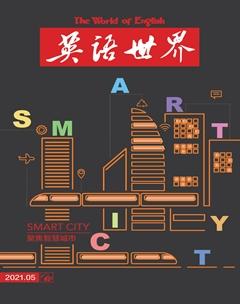What Does a Smart City Look Like? 智慧城市什么样?
卡亚·伊斯梅尔
Humans are flocking to cities, and cities are rapidly evolving—not just to accommodate more people, but to help them flourish.
With the UN forecasting that 68% of the worlds population will live in urban areas by 2050, an increasing number of cities are turning to Internet of Things (IoT) technologies to make their streets, trains, taxis and government services “smarter” to improve efficiency and quality of life.
But what exactly does a smart city look like, and are there any good examples already leading the way?
What exactly is a smart city?
A smart city refers to a metropolitan or cosmopolitan city that utilizes IoT technology to effectively manage the citys assets and resources which include sustainable energy, transportation, waste management and more. The main objective of using this technology is to improve the quality of life of the citys citizens from an economic, social and environmental level.
Kenta Yasukawa, co-founder and CTO of Soracom1, said any city that collects and analyzes data can be considered a smart city. “In practice, cities around the world are using connected sensors and big data analytics to improve life for residents and visitors across areas of governance ranging from traffic and transportation to power and water delivery, waste management, municipal services and law enforcement,” said Yasukawa.
As for the characteristics that define a smart city, Yasukawa shared that each smart city will have their own unique objective, but they all acknowledge the importance of IoT technology. “Some [smart cities] focus on innovation, others on infrastructure or overall efficiency. What they share in common is an understanding that emerging IoT and cloud capabilities offer a meaningful opportunity to better understand the intimate2 workings of an urban center. … and ultimately better serve its population while reducing both cost and waste.”
How can cities become smart?
Chris Wiegand, CEO and co-founder of Jibestream3, shared that the key for a city to become smart lies in how it can leverage4 both IoT technology and location-awareness. “By using sensors to process data and facilitate edge computing, they are able to manage infrastructure and resource allocation efficiently, resulting in a removal of friction from daily interactions and experiences for both municipal employees and city residents,” said Wiegand. He went on to explain that to make any space smart, “It is crucial to have a digitized representation of the city that is geospatially accurate at both street level and at the underground level, with indoor maps of subway paths and concourses and large public buildings.” This visual context of the city makes it easier to interpret the data provided by the IoT technology.
Wiegand also mentioned that you need to have the “requisite connectivity for devices and sensors to function properly.”
When asked whether any city can become smart, Wiegand said, “Any city can become a smart city, regardless of size, as long as it lays the key supporting infrastructure and has the commitment of citizens, municipal officials and local government and collaboration between public and private companies with the different levels of government.”
Examples of smart cities
To give you an idea of what a smart city looks like, we have identified the following “smart” cities:
Singapore—When Singapore rolled out its Smart Nation program5, the city embraced new technologies in every aspect of its infrastructure and operations. And in doing so, the city became a leading example for energy-efficient street lighting, which is responsive to weather changes. “The city of Singapore is arguably already the smartest city in the world, with the minute workings of the city rendered in data down to the backyard shortcuts children take on their way home from school,” said Wiegand.
Barcelona, Spain—In 2017, the city of Barcelona rolled out a mandate to “rethink the smart city from the ground up. ” Barcelona has, for time, been using IoT and cutting edge digital devices to municipal operations, but with the 2017 mandate there is now an emphasis to introduce a shift from “technology-first” to “citizen-first.”
“Barcelona expanded its smart applications and implemented open stand-ards-based platforms that integrate data from thousands of IoT devices that previously did not communicate with each other. Through reforming the citys network to become more adaptable and connected, Barcelona is considered one of the leading examples of smart cities,” said Daniele Loffreda, market development advisor and consultant for Ciena6.
Songdo, South Korea—Deborah Andrade, communication specialist at SlicingDice7, said Songdo in South Korea is considered to be a “world reference” for a smart city. “Songdo has Smart Work centers with teleconferencing systems that allow a third of its government staff to work closer to their homes that are equipped with Wi-Fi and sensor networks,” said Andrade.
Andrade added that Songdo was the first city to implement the Online Electric Vehicle Technology8 (OLEV) transportation system, which utilizes magnetic fields to generate electricity for buses.
“[Songdo] has an innovative IoT Cube9s lab, where different technology companies obtain real-time data from Songdos citizens and work together towards bringing better solutions and smart innovations for them,” said Andrade. ■
人们正涌向城市,城市也在迅速发展——不仅仅是为了容纳更多的人,也是为了让人们富足。
联合国预测,到2050年,世界上生活在城市地区的人口将达到68%,越来越多的城市开始使用物联网技术,从而使它们的街道、火车、出租车和政府服务“更有智慧”,以提高效率,改善生活质量。
但是,智慧城市到底是什么样子的呢?是否已经有一些成功范例了呢?
智慧城市到底是什么?
智慧城市是指利用物联网技术对城市资产和资源,包括可持续能源、交通、垃圾管理等,进行有效管理的大都市或国际大都市。使用这项技术的主要目的是从经济、社会和环境层面提高城市居民的生活质量。
Soracom联合创始人兼首席技术官安川健太表示,任何收集和分析数据的城市都可以被视为智慧城市。他说:“实际上,世界各地的城市都在使用互联的传感器和大数据分析来改善居民和访客的生活,涉及从交通运输到供电供水、垃圾管理、市政服务和执法等各个治理领域。”
至于用哪些特征来界定智慧城市,安川认为,每个智慧城市都有自己独特的目标,但所有城市都认可物联网技术的重要性。“一些(智慧城市)注重创新,另一些城市注重基础设施或整体效率。它们的共同之处在于,明白新兴的物联网和云端能力提供了一个重要的机会,让我们更好地了解城市中心的各种运作细节……最终在减少成本和损耗的同时更好地服务于居民。”
城市如何变得有智慧?
Jibestream的首席执行官兼联合创始人克里斯·威甘德认为,要使城市变得有智慧,关键在于如何利用物联网技术和位置感知。威甘德说:“通过使用传感器来进行数据处理和协助边缘计算,能够有效地管理基础设施和资源分配,使市政雇员和市民在日常交流和处理事务时都更顺畅。”他接着解释说,为了实现空间的智慧化,“关键是要有一个数字城市模型,准确呈现地面街道和地下网络的地理空间,有地铁路线、车站大厅和大型公共建筑的室内地图。”这种城市的可视情境使人们更容易解读物联网技术提供的数据。
威甘德还提到,你得有“设备和传感器正常工作所必需的连通性”。
当被问及是否任何城市都可以变得有智慧时,威甘德说:“任何城市,无论规模大小,都能发展成为智慧城市,只要搭建了關键性的配套基础设施,市民、市政官员和当地政府都倾力支持,公私企业与各级政府也协同合作”。
智慧城市范例
为了让你了解智慧城市,我们举以下“智慧”城市为例:
· 新加坡——当新加坡推出“智慧国家”计划时,在其基础设施和运营的各个方面都采用了新技术。通过这种做法,这座城市成为了节能型路灯的先进典范,这种路灯可感应天气变化,并随之调节照明亮度。威甘德说:“新加坡可以说已经是世界上最智慧的城市了,这座城市的细微运作情况皆由数据体现,数据的采集甚至覆盖到了孩子们放学回家从后院抄的近路。”
· 西班牙巴塞罗那——2017年,巴塞罗那市颁布了一项政令,“从头开始重新思考智慧城市”。巴塞罗那一度在市政运营中使用物联网和尖端的数字设备,但要完成这项政令,现在的工作重心要从“技术为本”转变到“市民为本”。
“巴塞罗那扩展了它的智慧型应用,并实现了基于标准的开放式平台,整合了来自数千个以前互不相通的物联网设备的数据。通过改造城市网络,巴塞罗那更具适应性和互联性,被视作智慧城市的一个领先范例。”Ciena市场开发顾问丹尼尔·洛弗雷达说。
· 韩国松岛——SlicingDice的通信专家黛博拉·安德拉德表示,韩国松岛被视为智慧城市的“世界参考”。“松岛拥有若干配备电话会议系统的‘智慧工作中心。在家里配备Wi-Fi和传感器网络,三分之一的政府工作人员便可以在离家更近的地方工作。”安德拉德说。
安德拉德补充说,松岛是第一个实现在线电动汽车技术交通系统的城市,该系统利用磁场为公交车发电。
安德拉德说:“(松岛)有一个创新型IoT Cube实验室,各家科技公司从那里获取松岛市民的实时数据,并共同努力为他们带来更好的解决方案和智慧创新。” □
(译者单位:福建省科技馆)
1一家移动虚拟网络运营商,与日本最大的电信公司NTT Docomo在3G及LTE业务方面展开合作,主要为IoT提供网络与电信基础设施建设服务。 2 intimate详细的。 3一种地图绘制解决方案,通过将业务数据与室内地图集成,为企业组织提供将智能添加到室内空间的工具。
4 leverage利用,应用。
5新加坡政府于2014年公布了“智慧国家2025”的10年计划(“智能城市2015”计划的升级版),致力于打造“智慧国”,建设覆盖全岛数据收集、连接和分析的基础设施和操作系统,以提供更好的公共服务。
6光纤通信设备制造商,总部位于美国马里兰州 。 7一家大数据初创公司,提供基于云的全方位服务数据仓库和分析式数据库即服务。 8这一技术允许电动公交车在路面上行驶时进行充电,即在道路中埋设线圈产生电磁波,通过安装在车辆下的装置将磁场能转化成电能。 9 IoT Cube公司的创新中心与应用开发者、大学和初创企业合作,测试和研发医疗、交通和制造业创新型解决方案。
- 英语世界的其它文章
- Smart City Vs. Normal City: What Are the Differences? 智慧城市与普通城市有何差别?
- A Smart City: More Than Just Tech 智慧城市不止科技
- Smart City: The Top Stories of 2020 2020年智慧城市杰出案例
- How the World Uses Digital Twins to Solidify Smart City Development 数字孪生助力智慧城市建设
- Covid-19 Unlocks the Potential of Smart Cities in China 新冠解锁中国智慧城市潜力
- The Shenzhen Effect 深圳效应

